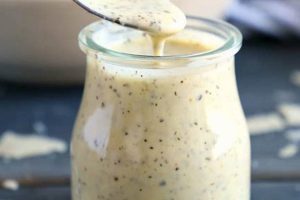A vibrant and flavorful complement to various salads, dressings featuring beetroots as a primary ingredient offer a unique blend of earthy sweetness and tangy acidity. These preparations typically combine cooked beetroots, often pured, with acidic components such as vinegar or citrus juice, and are enhanced with oils, herbs, spices, and sometimes dairy or sweeteners. A simple example might include pured beetroots, lemon juice, olive oil, Dijon mustard, and fresh dill.
Such dressings provide not only a burst of color and flavor but also potential health benefits. Beetroots are rich in nitrates, which can contribute to improved cardiovascular health, and antioxidants, known for their protective properties. Historically, beetroot’s culinary use dates back centuries, with evidence suggesting its consumption in ancient civilizations. While its greens were initially prized, the root itself eventually gained culinary prominence, finding its way into diverse dishes, including salads and, ultimately, their accompanying dressings.
This exploration will delve into a range of topics related to beetroot-based dressings, encompassing variations in ingredients, techniques for achieving desired textures and flavors, complementary salad pairings, and storage recommendations for optimal freshness.
Tips for Crafting Exceptional Beetroot Dressings
Achieving a balanced and flavorful beetroot dressing requires attention to detail and an understanding of how different ingredients interact. The following tips offer guidance for creating dressings that enhance both the visual appeal and taste of any salad.
Tip 1: Roasting vs. Boiling: Roasting beetroots intensifies their natural sweetness and earthy flavor, while boiling can result in a milder, less concentrated taste. Choose the cooking method based on the desired flavor profile.
Tip 2: Balancing Acidity: The earthy sweetness of beetroots necessitates a balancing acidic element. Lemon juice, red wine vinegar, or balsamic vinegar are excellent choices. Taste and adjust accordingly to achieve the desired balance.
Tip 3: Texture Considerations: A smooth, emulsified dressing is typically preferred. A blender or food processor ensures a consistent texture, especially when incorporating other ingredients like nuts or herbs.
Tip 4: Flavor Enhancements: Fresh herbs such as dill, mint, or chives add brightness and complexity. Spices like cumin, coriander, or a pinch of cayenne pepper can introduce warmth and depth.
Tip 5: Oil Selection: Extra virgin olive oil offers a robust flavor that complements beetroots well. Other options include walnut oil for a nutty nuance or avocado oil for a milder taste.
Tip 6: Storage & Freshness: Store dressings in an airtight container in the refrigerator for up to five days. Allow the dressing to come to room temperature before serving for optimal flavor.
Tip 7: Pairing Considerations: Beetroot dressings pair well with salads featuring goat cheese, walnuts, arugula, or citrus segments. Consider the other salad components when selecting ingredients for the dressing.
By following these guidelines, one can create beetroot dressings that not only elevate salads but also offer a nutritional boost. Careful consideration of flavor pairings, textures, and ingredient quality ensures a delightful culinary experience.
These techniques and considerations provide a solid foundation for exploring the versatility of beetroot dressings and their potential to enhance a wide range of culinary creations.
1. Ingredients
The quality and selection of ingredients directly influence the final character of a beetroot salad dressing. Beetroots themselves provide the foundational flavor, offering earthy sweetness and vibrant color. Their preparation, whether roasted, boiled, or pickled, affects the intensity of these characteristics. Acidity, derived from ingredients like vinegar or citrus juice, balances the sweetness and adds brightness. The type of acid employed, such as lemon juice, red wine vinegar, or balsamic vinegar, introduces subtle nuances to the overall flavor profile. Oils contribute richness and texture, with options like extra virgin olive oil, walnut oil, or avocado oil each imparting distinct characteristics.
Further complexity arises from the inclusion of additional components. Fresh herbs, such as dill, mint, or parsley, introduce aromatic notes and freshness. Spices like cumin, coriander, or black pepper provide depth and warmth. Sweeteners, including honey or maple syrup, can further modulate the balance of flavors, while elements like Dijon mustard or horseradish contribute sharpness and complexity. Dairy components, such as yogurt or sour cream, introduce creamy textures and tangy notes. The careful selection and proportion of these ingredients determine the ultimate flavor profile of the dressing, enabling a spectrum of possibilities from tangy and vibrant to sweet and earthy.
Understanding the interplay of these ingredients is fundamental to crafting a successful beetroot salad dressing. The choice of each component contributes not only to the flavor but also to the texture, color, and overall balance. A well-considered ingredient list ensures a dressing that complements the salad itself, enhancing the dining experience.
2. Preparation Method
Preparation methods significantly influence the flavor, texture, and color of beetroot salad dressings. Roasting beetroots intensifies their natural sweetness and concentrates their flavor, producing a deep, earthy taste. This method also imparts a slightly smoky aroma and tender texture. Boiling, while faster, can result in a milder flavor and a less vibrant hue, potentially leaching out some of the beetroot’s color and nutrients into the cooking water. Steaming offers a compromise, preserving more nutrients and color compared to boiling while still achieving a tender texture. Pickling, a less common approach for dressings, introduces a tangy, acidic dimension, transforming the beetroot’s flavor profile entirely. The choice of preparation method thus directly impacts the final characteristics of the dressing and its suitability for different salad combinations.
For instance, a roasted beetroot dressing might pair well with robust greens like kale or arugula and complement ingredients like toasted walnuts or goat cheese. A dressing made with boiled beets, given its milder flavor, might be more suitable for delicate greens like spinach or butter lettuce and pair with lighter additions like feta cheese or citrus segments. The texture of the beets also changes depending on the preparation method, influencing the final consistency of the dressing. Roasted beets blend into a smoother puree, while boiled beets, especially if slightly undercooked, might retain some texture, lending a slightly chunky character to the dressing. This textural variation allows for further customization and creativity in recipe development.
Careful consideration of preparation methods allows for precise control over the final product. Understanding the impact of each technique on the beetroot’s inherent properties enables the creation of dressings tailored to specific flavor profiles and desired textures. Selecting the appropriate method is crucial for achieving a harmonious balance within the salad as a whole, ensuring the dressing complements rather than overwhelms the other ingredients.
3. Flavor Balance
Flavor balance is paramount in a successful beetroot salad dressing recipe. The inherent earthy sweetness of beetroot requires careful counterbalance to prevent the dressing from becoming cloying. This balance is typically achieved through the introduction of acidity, which cuts through the sweetness and adds brightness. Common acidic ingredients include lemon juice, vinegar (red wine, balsamic, apple cider), or even a touch of citrus zest. The intensity of the chosen acid should be considered; for example, balsamic vinegar offers a richer, sweeter acidity compared to the sharper tang of lemon juice. The ratio of beetroot to acid is crucial, requiring careful adjustment according to the desired flavor profile. A dressing intended for a salad with peppery arugula might require more acidity than one paired with milder spinach. Furthermore, acidity levels can impact the dressing’s color, with higher acidity potentially brightening the hue.
Beyond acidity, other elements contribute to a well-rounded flavor profile. Salt enhances the sweetness of the beetroot and balances the other flavors. The type of salt can also subtly influence the taste; flaky sea salt offers a different textural and flavor experience compared to finely ground table salt. Fat, typically in the form of oil, adds richness and mouthfeel. The choice of oil, such as extra virgin olive oil, walnut oil, or avocado oil, introduces distinct flavor nuances that should complement the overall composition. Spices and herbs further enhance complexity; dill, mint, or chives provide fresh, herbaceous notes, while cumin or coriander add warmth and depth. A touch of sweetness, from honey or maple syrup, can round out the flavor profile, especially when paired with stronger acidic components. For example, a dressing with balsamic vinegar might benefit from a touch of honey to balance its inherent sweetness. These additional elements should be used judiciously, ensuring they enhance rather than overwhelm the core beetroot flavor.
Achieving optimal flavor balance necessitates a nuanced understanding of ingredient interactions and careful tasting throughout the preparation process. It is not a static formula but rather a dynamic interplay of tastes that requires constant adjustment. Overly acidic dressings can be tempered with a touch of sweetener or a richer oil. Dressings lacking brightness can benefit from a squeeze of lemon or a splash of vinegar. The ultimate goal is to create a harmonious blend where no single flavor dominates, allowing the natural sweetness and earthiness of the beetroot to shine through while being complemented by the other components. This careful orchestration of flavors elevates the beetroot salad dressing from a simple condiment to an integral part of the culinary experience.
4. Texture
Texture plays a crucial role in the overall sensory experience of a beetroot salad dressing. It contributes not only to the mouthfeel but also influences how the dressing coats the salad ingredients and interacts with the palate. The desired texture can range from perfectly smooth and creamy to coarsely textured with discernible pieces of beetroot or other ingredients. Achieving the intended texture requires careful consideration of ingredient preparation and processing techniques.
- Smooth and Creamy
A smooth, emulsified texture is often preferred for beetroot dressings, creating a luxurious mouthfeel and ensuring even distribution over the salad. This texture is typically achieved by blending or processing the cooked beetroots with other ingredients until completely smooth. The addition of emulsifying agents, such as a small amount of Dijon mustard or tahini, can help stabilize the emulsion and prevent separation. This smooth texture is particularly well-suited for dressings intended for more delicate greens or salads incorporating creamy cheeses.
- Chunky and Rustic
A chunkier texture offers a contrasting textural element to the salad, providing bursts of beetroot flavor and a more rustic appeal. This can be achieved by coarsely chopping or grating the cooked beetroots instead of pureeing them. The size of the beetroot pieces can be adjusted to suit individual preferences and the overall composition of the salad. This texture is often preferred for salads with heartier greens or those incorporating crunchy elements like nuts or seeds.
- Influence of Added Ingredients
The texture of a beetroot dressing can be further modified by the inclusion of other ingredients. Adding toasted nuts or seeds introduces a pleasant crunch, while incorporating crumbled cheese contributes a creamy, crumbly element. Fresh herbs, though primarily contributing to flavor, also add a subtle textural dimension. These additions can complement either a smooth or chunky base, providing further complexity and interest.
- Temperature’s Effect
Temperature also plays a role in the perceived texture of the dressing. A chilled dressing will typically feel thicker and more viscous than one served at room temperature. This difference can be leveraged to fine-tune the dressing’s consistency. For example, a slightly thinner dressing can be chilled to achieve the desired thickness before serving.
The interplay of these textural elements significantly contributes to the overall enjoyment of a beetroot salad. By understanding the factors that influence texture and employing appropriate techniques, one can create dressings that not only enhance the flavor but also elevate the sensory experience of the salad as a whole. Whether a smooth and creamy emulsion or a rustic and chunky preparation, the chosen texture should harmonize with the other salad components, creating a balanced and satisfying culinary composition.
5. Pairing Suggestions
Pairing suggestions are integral to a comprehensive understanding of beetroot salad dressing recipes. Effective pairings elevate the sensory experience, transforming a simple salad into a cohesive and balanced culinary creation. The inherent characteristics of beetroot dressingsearthy, sweet, and tangynecessitate careful consideration of complementary ingredients. These pairings are not arbitrary but rather based on flavor affinities and textural contrasts that enhance the overall composition.
Several factors influence pairing decisions. The intensity of the beetroot flavor, affected by cooking methods and the proportion of other ingredients in the dressing, dictates the strength of complementary flavors. A robust, roasted beetroot dressing might pair well with bold ingredients like pungent cheeses (goat, blue) or bitter greens (arugula, radicchio). A milder dressing, perhaps made with boiled beets and a lighter vinaigrette, might complement delicate greens (spinach, butter lettuce) and fresh herbs (dill, mint). Textural considerations are equally important. A smooth, emulsified dressing harmonizes with creamy cheeses and crunchy nuts or seeds, offering a contrast in textures. A chunkier dressing, incorporating pieces of beetroot or other vegetables, might pair well with grains or roasted vegetables, creating a more substantial salad.
Specific examples illustrate these principles. A salad featuring roasted beets, goat cheese, candied walnuts, and arugula, dressed with a balsamic-beetroot vinaigrette, demonstrates a successful interplay of flavors and textures. The tangy goat cheese complements the earthy beets, while the sweetness of the candied walnuts balances the acidity of the dressing. The peppery arugula provides a contrasting bitterness. Conversely, a salad with boiled beets, feta cheese, cucumber, and dill, dressed with a lemon-beetroot vinaigrette, offers a lighter, more refreshing profile. The salty feta complements the mild beets, while the cucumber adds a cooling element. The fresh dill enhances the brightness of the lemon in the dressing. These examples showcase the importance of considering the interplay of all ingredients, including the dressing, to achieve a harmonious and satisfying culinary experience. Careful attention to pairing suggestions maximizes the potential of beetroot salad dressings, transforming them from mere condiments into integral components of well-crafted salads.
6. Storage
Proper storage is essential for maintaining the quality, flavor, and safety of beetroot salad dressings. Improper storage can lead to undesirable changes in texture, color, and taste, as well as potential microbial growth. Understanding appropriate storage techniques ensures the dressing remains vibrant and flavorful, maximizing its shelf life and contributing to a positive culinary experience.
- Container Selection
Choosing the right container is crucial for optimal storage. Airtight containers, preferably made of glass or food-grade plastic, are ideal. These containers minimize exposure to oxygen, which can cause oxidation and lead to discoloration and flavor degradation. The size of the container should be appropriate for the quantity of dressing, minimizing the amount of headspace, which can also contribute to oxidation. Avoid using reactive metals, such as copper or aluminum, as they can interact with the acidic components of the dressing.
- Refrigeration
Refrigeration is essential for preserving beetroot salad dressings. The cool temperature slows down microbial growth and enzymatic activity, which can cause spoilage. Dressings should be stored in the refrigerator as soon as possible after preparation and kept at a consistent temperature below 40F (4C). Avoid storing dressings in the door of the refrigerator, as temperature fluctuations in this area can accelerate spoilage.
- Shelf Life
Even with proper storage, beetroot salad dressings have a limited shelf life. Generally, homemade dressings can be stored in the refrigerator for up to five days. Factors such as the ingredients used, the acidity level, and storage conditions can influence the actual shelf life. Always check for signs of spoilage, such as mold growth, off-odors, or changes in texture, before consuming. Discard any dressing that shows signs of deterioration.
- Freezing (Optional)
While not always ideal, beetroot salad dressings can sometimes be frozen for longer-term storage. However, freezing can alter the texture and emulsion stability of the dressing, especially if it contains dairy or emulsifying agents. If freezing, use airtight freezer-safe containers, leaving some headspace for expansion. Thaw the dressing thoroughly in the refrigerator before use and whisk or blend to re-emulsify if necessary. Be aware that the texture may not be identical to the freshly prepared dressing.
Adhering to these storage guidelines ensures the longevity and quality of beetroot salad dressings, preserving their vibrant color, fresh flavors, and safe consumption. By understanding the factors that influence preservation, one can maximize the enjoyment of these dressings and their contribution to a variety of culinary creations.
Frequently Asked Questions
This section addresses common inquiries regarding beetroot salad dressing recipes, offering practical guidance and clarifying potential uncertainties.
Question 1: How can one prevent beetroot from staining other ingredients in the salad?
Adding the dressing just before serving minimizes staining. Alternatively, lightly coating the other salad components in oil creates a barrier.
Question 2: What are suitable alternatives to vinegar for achieving acidity in the dressing?
Citrus juices, such as lemon or orange, provide acidity and introduce complementary flavors. Pickled beetroot brine also offers a tangy alternative.
Question 3: Can honey be substituted for sugar in beetroot dressings?
Honey offers a more complex sweetness and can be substituted for sugar. Adjust the quantity according to taste, as honey is sweeter than granulated sugar.
Question 4: How can the intensity of the beetroot flavor be adjusted in the dressing?
Roasting intensifies the beetroot flavor, while boiling results in a milder taste. Adjusting the quantity of beetroot in the recipe also modifies the intensity.
Question 5: What measures can be taken to ensure a smooth, emulsified dressing?
Using a blender or food processor creates a smooth emulsion. Adding a small amount of Dijon mustard or tahini helps stabilize the mixture.
Question 6: How can the shelf life of beetroot salad dressing be extended?
Storing the dressing in an airtight container in the refrigerator extends its shelf life. Freezing is possible, but may alter the texture.
Understanding these aspects of beetroot salad dressing preparation enhances culinary outcomes and allows for greater control over flavor profiles and textures. Addressing these common inquiries promotes successful recipe implementation and culinary satisfaction.
The following section will provide specific recipe examples, illustrating these principles in practical applications.
Conclusion
Beetroot salad dressing recipes offer a versatile and vibrant addition to culinary endeavors. Careful consideration of ingredient selection, preparation methods, flavor balancing, textural elements, and pairing suggestions allows for a wide range of flavor profiles and culinary applications. Proper storage techniques ensure the longevity and quality of these dressings. From the earthy sweetness of roasted beetroot paired with tangy goat cheese and peppery arugula to the refreshing combination of boiled beets, feta, and dill, the possibilities are extensive.
Exploration of these elements empowers culinary creativity and enhances the dining experience. The versatility of beetroot salad dressings provides a platform for innovative flavor combinations and textural explorations, enriching culinary traditions and inspiring further development within the gastronomic landscape.






